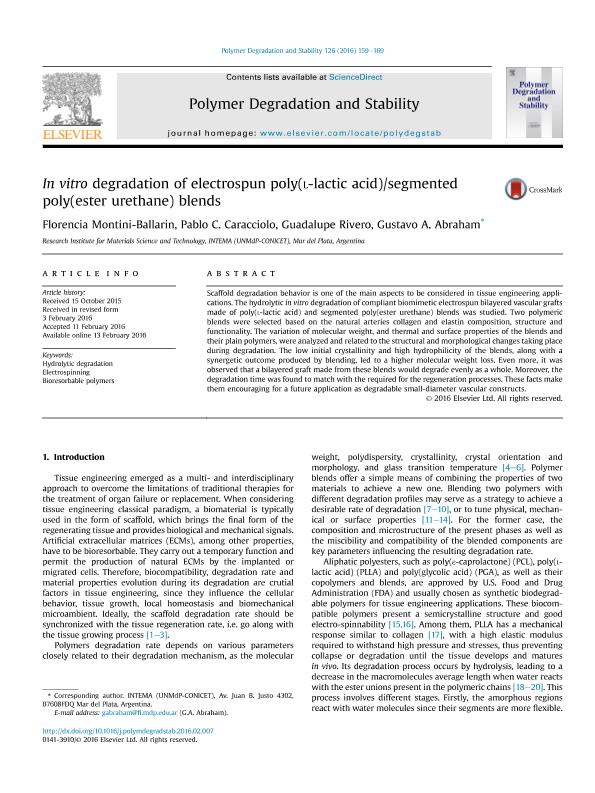Artículo
In vitro degradation of electrospun poly(l-lactic acid)/segmented poly(ester urethane) blends
Montini Ballarin, Florencia ; Caracciolo, Pablo Christian
; Caracciolo, Pablo Christian ; Rivero, Guadalupe
; Rivero, Guadalupe ; Abraham, Gustavo Abel
; Abraham, Gustavo Abel
 ; Caracciolo, Pablo Christian
; Caracciolo, Pablo Christian ; Rivero, Guadalupe
; Rivero, Guadalupe ; Abraham, Gustavo Abel
; Abraham, Gustavo Abel
Fecha de publicación:
04/2016
Editorial:
Elsevier
Revista:
Polymer Degradation And Stability
ISSN:
0141-3910
Idioma:
Inglés
Tipo de recurso:
Artículo publicado
Clasificación temática:
Resumen
Scaffold degradation behavior is one of the main aspects to be considered in tissue engineering applications. The hydrolytic in vitro degradation of compliant biomimetic electrospun bilayered vascular grafts made of poly(l-lactic acid) and segmented poly(ester urethane) blends was studied. Two polymeric blends were selected based on the natural arteries collagen and elastin composition, structure and functionality. The variation of molecular weight, and thermal and surface properties of the blends and their plain polymers, were analyzed and related to the structural and morphological changes taking place during degradation. The low initial crystallinity and high hydrophilicity of the blends, along with a synergetic outcome produced by blending, led to a higher molecular weight loss. Even more, it was observed that a bilayered graft made from these blends would degrade evenly as a whole. Moreover, the degradation time was found to match with the required for the regeneration processes. These facts make them encouraging for a future application as degradable small-diameter vascular constructs.
Palabras clave:
Bioresorbable Polymers
,
Electrospinning
,
Hydrolytic Degradation
Archivos asociados
Licencia
Identificadores
Colecciones
Articulos(CCT - MAR DEL PLATA)
Articulos de CTRO.CIENTIFICO TECNOL.CONICET - MAR DEL PLATA
Articulos de CTRO.CIENTIFICO TECNOL.CONICET - MAR DEL PLATA
Articulos(INTEMA)
Articulos de INST.DE INV.EN CIENCIA Y TECNOL.MATERIALES (I)
Articulos de INST.DE INV.EN CIENCIA Y TECNOL.MATERIALES (I)
Citación
Montini Ballarin, Florencia; Caracciolo, Pablo Christian; Rivero, Guadalupe; Abraham, Gustavo Abel; In vitro degradation of electrospun poly(l-lactic acid)/segmented poly(ester urethane) blends; Elsevier; Polymer Degradation And Stability; 126; 4-2016; 159-169
Compartir
Altmétricas



